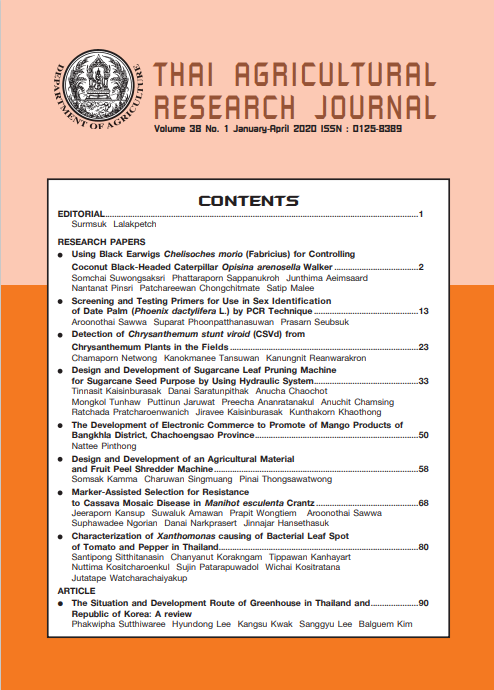Marker-assisted selection for resistance to cassava mosaic disease in Manihot esculenta Crantz
DOI:
https://doi.org/10.14456/thaidoa-agres.2020.6Keywords:
Cassava (Manihot esculentaCrantz), Cassava mosaic disease (CMD), Marker-assisted selectionAbstract
Cassava Mosaic Disease (CMD) is a very important disease that causes damage to cassava production. The objective of this research was to select cassava varieties resistant to CMD by using molecular markers. Two hundred fifty varieties collected from Rayong Field Crops Research Center were examined using molecular markers in the laboratory of Biotechnology Research and Development Office, Department of Agriculture from October 2017 to September 2019. In this research, 3 groups of molecular markers were used in selection for resistance to CMD. Group 1 included 4 Sequence Characterized Amplified Region (SCAR) and Simple Sequence Repeat (SSR) markers, namely RME1, NS158, SSRY28 and NS169 which are flanking nearby the CMD resistance gene called CMD2. Group 2 consisted of 2 molecular markers, namely EST-LRR and NB-ARC domains-containing disease resistance protein (EST-R protein) and EST-Protein kinase superfamily protein (EST-Kinase) which were obtained from the expressed sequence tags of genes in response to cassava mosaic virus, the cause of CMD. Group 3 contained 3 positions of Single Nucleotide Polymorphism (SNP) markers in Peroxidase gene, namely Ex2-78, Ex2-157 and Ex3-128. In total, 9 molecular markers were used to find out cassava varieties showing DNA band patterns and nucleotide sequences similar to those of the CMD resistant variety named TME3. The results of the experiment found that there were 2 varieties showing the same DNA band patterns and nucleotide sequences as TME3 in all 9 molecular markers, namely MMAL63 and CMR23-149-59. These varieties may be resistant to CMD. However, it is necessary to evaluate the resistance of these cassava varieties against the existing cassava mosaic virus before using such varieties for breeding and propagation to farmers.
References
มณฑล เลิศวรปรีชา. 2554. Pyrosequencing : วิธีการใหม่สำหรับการวิเคราะห์ลำดับนิวคลีโอไทด์และการประยุกต์ในงานวิจัยทางจุลชีววิทยา. ว. ม.ทักษิณ 14 (1): 111 – 118.
สำนักงานเศรษฐกิจการเกษตร. 2562. สถิติการเกษตรของประเทศไทย ปี 2561. กระทรวงเกษตรและสหกรณ์ กรุงเทพมหานคร. ISSN 0857 6610. 186 หน้า.
ศูนย์สารสนเทศการเกษตร สำนักงานเศรษฐกิจการเกษตร. 2562. สถิติการค้าสินค้าเกษตรไทยกับต่างประเทศปี 2561. กระทรวงเกษตรและสหกรณ์ ISSN 0858 2327. 143 หน้า.
Akano, A.O., A.G.O. Dixon, C. Mba, E. Barrera and M. Fregene. 2002. Genetic mapping of a dominant gene conferring resistance to cassava mosaic disease. Theor. Appl. Genetics. 105: 521-525.
Bi, H., M. Aileni and P. Zhang. 2010. Evaluation of cassava varieties for cassava mosaic disease resistance jointly by agro-inoculation screening and molecular markers. Afr. J. Plant Sci. 4: 330-338.
Carmo, C.D., M.S. Silva, G.A.F. Oliveira and E.J. Oliveira. 2015. Molecular-assisted selection for resistance to cassava mosaic disease in Manihot esculenta Crantz. Sci. Agric. 72(6): 520-527.
Centro Internacional de Agricultura Tropical (CIAT). 2007. Cassava Research and Development in Asia: Exploring New Opportunities for an Ancient Crop. Proc. 7th Regional Workshop, held in Bangkok, Thailand. Oct 28- Nov 1, 2002. 668 p.
Fregene, M., N. Morante, T. Sánchez, J. Marin, C. Ospina, E. Barrera, J. Gutierrez, J. Guerrero, A. Bellotti, L. Santos, A. Alzate, S. Moreno and H. Ceballos. 2006. Molecular markers for introgression of useful traits from wild Manihot relatives of cassava, marker-assisted selection (MAS) of disease and root quality traits. J. Root. Crops. 32: 1-31.
Lokko,Y., E.Y. Danquah, S.K. Offei, A.G.O. Dixon and M.A. Gedil. 2005. Molecular markers associated with a new source of resistance to the cassava mosaic disease. Afr. J. Biotechnol. 4 (9): 873-881.
Okogbenin, E., M.C.M. Porto, C. Egesi, C. Mba, E. Ospinosa, L.G. Santos, C. Ospina, J. Marin, E. Barera, J. Gutierrez, I. Ekanayake, C. Iglesias and M. Fregene. 2007. Marker aided introgression of CMD resistance in Latin American germplasm for genetic improvement of cassava in Africa. Crop. Sci. 47: 1895-1904.
Ribeiro, P.F., R. Akromah and J. Manu-Aduening. 2012. Using marker assisted selection to hasten screening of cassava cultivars developed through introgression of Cassava Mosaic Disease (CMD) resistance into cassava landraces in Ghana. J. Agr. Sci. Tech. B 2: 74-80.
Romeis, T. 2001. Protein kinases in the plant defence response. Curr. Opin. Plant. Biol. 4: 407–414.
Van Ooijen, G., G. Mayr, M.M.A. Kasiem, M. Albrecht, B.J.C. Cornelissen and F.L.W. Takken. 2008. Structure–function analysis of the NB-ARC domain of plant disease resistance proteins. J. Exp. Bot. 59(6): 1383–1397.
Wolfe, M. D., I. Y. Rabbi, C. Egesi, M. Hamblin, R. Kawuki, P. Kulakow, R. Lozano, D. P. D. Carpio, P. Ramu, and J. Jannink. 2016. Genome-Wide Association and Prediction Reveals Genetic Architecture of Cassava Mosaic Disease Resistance and Prospects for Rapid Genetic Improvement. Plant Genome 9. doi:10.3835/plantgenome2015.11.0118
Downloads
Published
How to Cite
Issue
Section
License
Copyright (c) 2020 Thai Agricultural Research Journal

This work is licensed under a Creative Commons Attribution-NonCommercial-NoDerivatives 4.0 International License.
Thai Agricultural Research Journal



